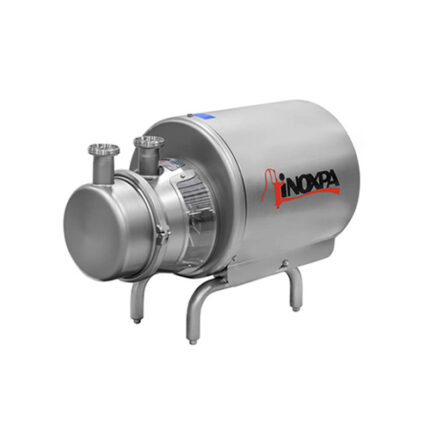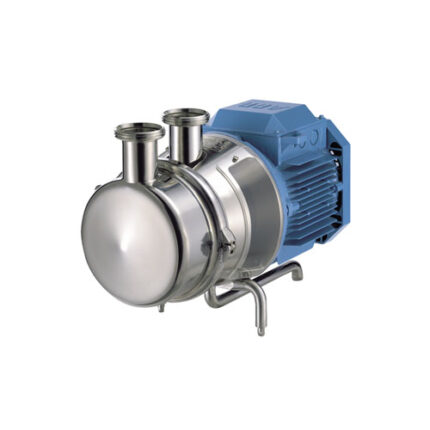A self-priming pump is a type of pump that absorbs water or other liquids and carries them through pipes or hoses at a high pressure.
The self-priming pump type can work even when the water level or liquid level changes because it has self-priming feature to suck up the liquid.
The operation of the self-priming pump begins with the pump absorbing the liquid, creating a vacuum in the suction pipe. The suction pipe in the pump body is placed in a well under the pump body. The pump performs suction by immersing the suction pipe in water or other liquids. During this process, the rotating part of the pump draws the liquid into the pump body and is then pushed forward through the pipe or hose.
Types of self-priming pumps are:
Showing the single result
Aspir Self-Priming Pumps
ASPIR Self-Priming Pumps are suitable for use in food processes, pharmaceutical and chemical industries. It is generally used for the transfer of products at temperatures close to the boiling point such as oil, wine, alcohol, acetone. Its main application is as a CIP return pump.
Gear pump with self-priming feature can transfer the product by sucking from a distance of 4-5 meters. It is extensively used in CIP systems, food applications and fluid transfers containing steam.- Jet Pumps: Jet pumps are a type of self-priming pump that pumps water at high pressure by sucking the water in the suction pipe. Compared to the submersible pump, jet pumps offer higher efficiency and longer life.
- Turbine Pumps: Turbine pumps are a type of self-priming pump with multiple small impellers that draw fluid into the pump body and then push it forward through hoses or pipes.
- Self-Priming Submersible Pumps: A self-priming submersible pump is a pump that sucks and transports liquid through pipes or hoses. It is also known as a submersible pump and is particularly ideal for removing water from springs, wells or cisterns.
- Self-Priming Hose Pumps: Self-priming hose pumps are a type of pump that absorbs liquid with a large diameter hose and carries it through high-pressure pipes or hoses. Hose sizes can vary and can be used to transport large volumes of water or liquids.
The use of self-priming pumps is widely used in many fields, especially for supplying water from water sources, industrial applications, irrigation in farms and gardens.
Usage Areas of Self-Priming Pumps:
- Agriculture and Irrigation:
- Pumping water in irrigation systems.
- Withdrawing water from fields, ponds or rivers.
- Industry and Construction:
- Transportation of chemicals.
- Discharge of water from construction sites.
- Discharge of water in mining.
- Home and Garden Use:
- Garden irrigation systems.
- Cleaning of swimming pools.
- For domestic water supply.
- Marine and Ship Industry:
- Discharge of ship bilge water.
- Transfer of sea water.
- Municipality and Infrastructure:
- Sewerage and wastewater systems.
- Storm water and flood control.
- Fire Suppression Systems:
- For rapid withdrawal and pumping of water in fire suppression systems.
Advantages of Self-Priming Pumps
- Easy Installation:
- Self-priming pumps can be installed quickly and easily because they do not require a suction line filled with water.
- Fast Priming:
- They have the capacity to quickly draw water, which saves time.
- Easy Maintenance:
- They are generally easy to maintain and cost-effective.
- Flexibility:
- They can be used for a variety of fluids, which provides a wide range of applications.
- High Durability:
- Most self-priming pumps are designed to withstand harsh conditions and have a long life.
- Low Risk:
- Self-priming pumps are generally less prone to damage, even when run dry.
Disadvantages
- Efficiency:
- They may have slightly lower efficiency than other pump types.
- Limited Pressure:
- They may not perform adequately in applications requiring high pressure.
- Air Accumulation Problems:
- Their performance may be reduced if air accumulates, which may require frequent system inspections.
- Limited Height Capacity:
- They may not be suitable for drawing water from very high altitudes.
- Restricted Fluid Types:
- They may not be suitable for certain chemicals or corrosive fluids.
Purposes of Use
- Emergency Water Supply: Provides rapid water supply, especially in emergencies such as agriculture, construction or firefighting.
- Ease of Relocation: Being suitable for mobile applications allows them to be easily used in situations requiring relocation.
- Energy Efficiency: Provides energy efficiency in water supply and drainage processes, because they do not require a suction line filled with water during initial operation.
- Environmental Protection: Plays an important role in environmental protection applications such as rapid discharge of wastewater and flood control.
- Economic Solutions: Provides low-cost and effective solutions, especially in small and medium-sized applications.
Self-priming pumps are flexible and versatile pumps that can be used in a wide range of applications. Their advantages such as quick installation, ease of maintenance and durability make them ideal for many industrial and domestic applications. However, it is important to consider their suitability for the intended use and their disadvantages.
 Stainless Steel Products
Stainless Steel Products Mixing
Mixing Pumps
Pumps Heat Exchangers
Heat Exchangers System Solutions
System Solutions





